Leadership for Managers: Theories, Styles, and Motivation Report
VerifiedAdded on 2022/10/10
|13
|2899
|378
Report
AI Summary
This report delves into the critical role of effective leadership styles in achieving organizational success. It explores various leadership theories, including Maslow's hierarchy of needs and Herzberg's two-factor theory, highlighting their significance in employee motivation and engagement. The report examines different leadership styles such as autocratic, democratic, laissez-faire, and transformational, assessing their impact on workplace dynamics. It also emphasizes the importance of communication, adaptability, and team development skills for managers. The report provides insights into how organizations like Sony utilize effective leadership to foster employee growth and productivity. The conclusion underscores the foundational role of leadership skills in creating a supportive and appreciative work environment, ultimately driving organizational performance. The report also includes a personal reflection on leadership experiences and preferences.
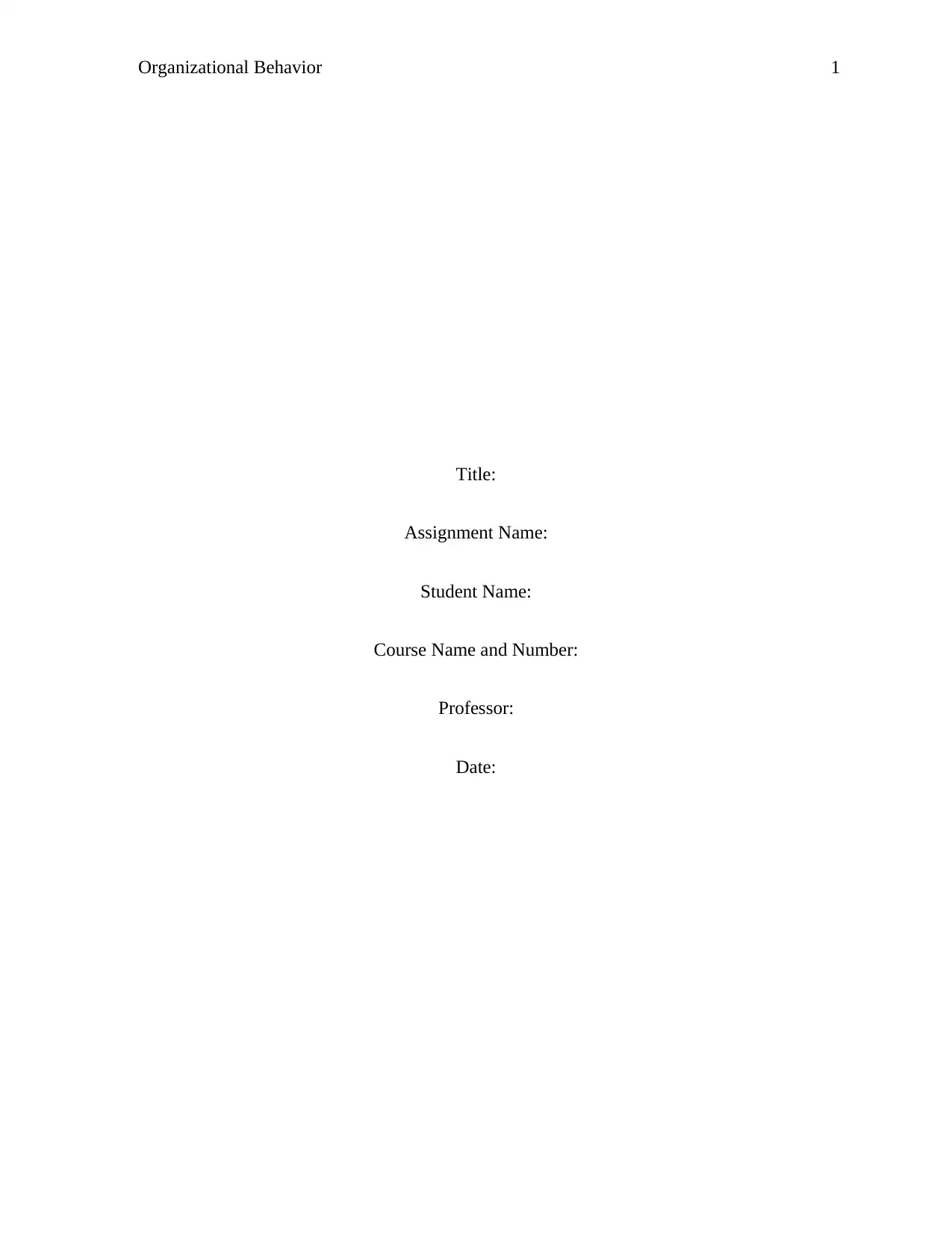
Organizational Behavior 1
Title:
Assignment Name:
Student Name:
Course Name and Number:
Professor:
Date:
Title:
Assignment Name:
Student Name:
Course Name and Number:
Professor:
Date:
Paraphrase This Document
Need a fresh take? Get an instant paraphrase of this document with our AI Paraphraser
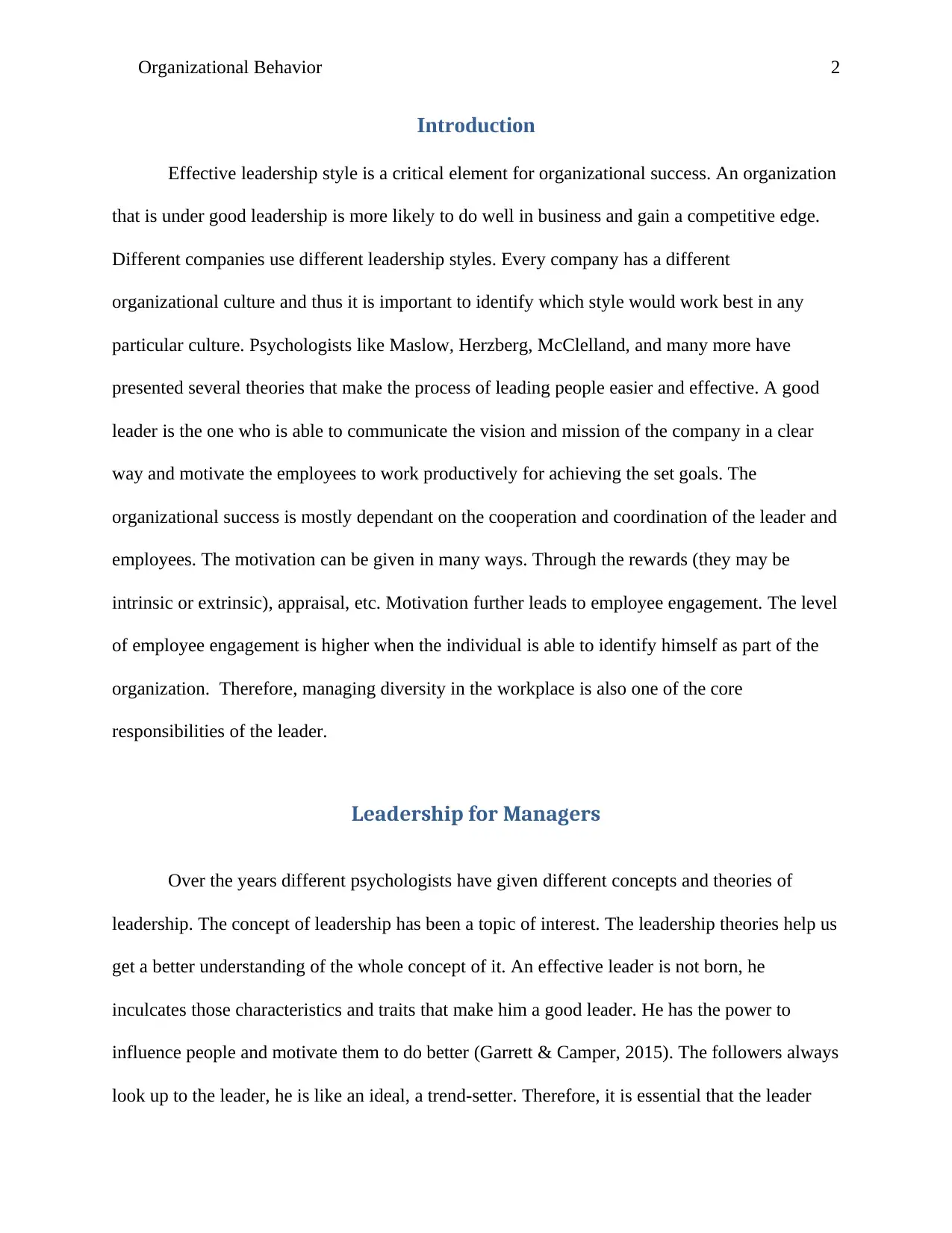
Organizational Behavior 2
Introduction
Effective leadership style is a critical element for organizational success. An organization
that is under good leadership is more likely to do well in business and gain a competitive edge.
Different companies use different leadership styles. Every company has a different
organizational culture and thus it is important to identify which style would work best in any
particular culture. Psychologists like Maslow, Herzberg, McClelland, and many more have
presented several theories that make the process of leading people easier and effective. A good
leader is the one who is able to communicate the vision and mission of the company in a clear
way and motivate the employees to work productively for achieving the set goals. The
organizational success is mostly dependant on the cooperation and coordination of the leader and
employees. The motivation can be given in many ways. Through the rewards (they may be
intrinsic or extrinsic), appraisal, etc. Motivation further leads to employee engagement. The level
of employee engagement is higher when the individual is able to identify himself as part of the
organization. Therefore, managing diversity in the workplace is also one of the core
responsibilities of the leader.
Leadership for Managers
Over the years different psychologists have given different concepts and theories of
leadership. The concept of leadership has been a topic of interest. The leadership theories help us
get a better understanding of the whole concept of it. An effective leader is not born, he
inculcates those characteristics and traits that make him a good leader. He has the power to
influence people and motivate them to do better (Garrett & Camper, 2015). The followers always
look up to the leader, he is like an ideal, a trend-setter. Therefore, it is essential that the leader
Introduction
Effective leadership style is a critical element for organizational success. An organization
that is under good leadership is more likely to do well in business and gain a competitive edge.
Different companies use different leadership styles. Every company has a different
organizational culture and thus it is important to identify which style would work best in any
particular culture. Psychologists like Maslow, Herzberg, McClelland, and many more have
presented several theories that make the process of leading people easier and effective. A good
leader is the one who is able to communicate the vision and mission of the company in a clear
way and motivate the employees to work productively for achieving the set goals. The
organizational success is mostly dependant on the cooperation and coordination of the leader and
employees. The motivation can be given in many ways. Through the rewards (they may be
intrinsic or extrinsic), appraisal, etc. Motivation further leads to employee engagement. The level
of employee engagement is higher when the individual is able to identify himself as part of the
organization. Therefore, managing diversity in the workplace is also one of the core
responsibilities of the leader.
Leadership for Managers
Over the years different psychologists have given different concepts and theories of
leadership. The concept of leadership has been a topic of interest. The leadership theories help us
get a better understanding of the whole concept of it. An effective leader is not born, he
inculcates those characteristics and traits that make him a good leader. He has the power to
influence people and motivate them to do better (Garrett & Camper, 2015). The followers always
look up to the leader, he is like an ideal, a trend-setter. Therefore, it is essential that the leader
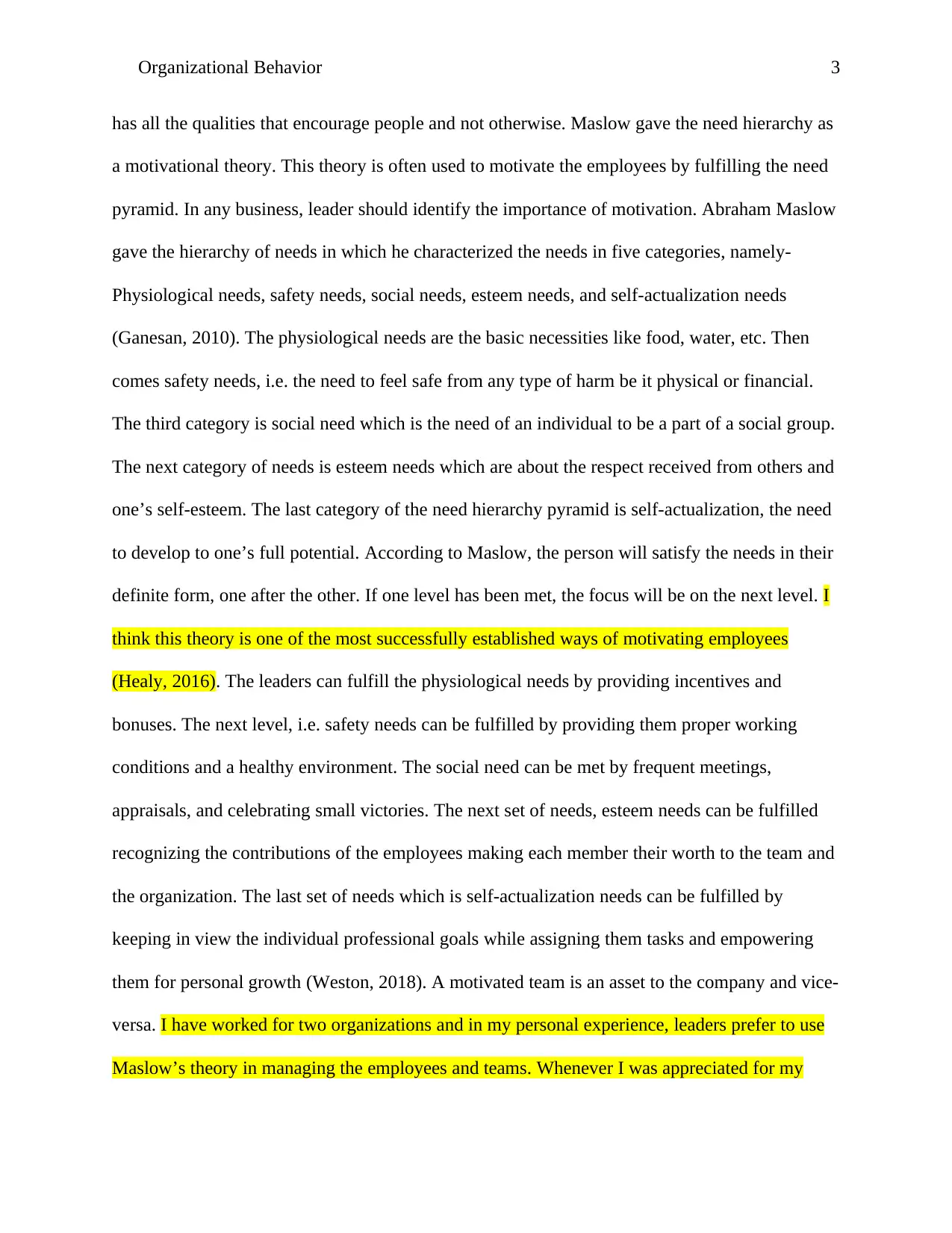
Organizational Behavior 3
has all the qualities that encourage people and not otherwise. Maslow gave the need hierarchy as
a motivational theory. This theory is often used to motivate the employees by fulfilling the need
pyramid. In any business, leader should identify the importance of motivation. Abraham Maslow
gave the hierarchy of needs in which he characterized the needs in five categories, namely-
Physiological needs, safety needs, social needs, esteem needs, and self-actualization needs
(Ganesan, 2010). The physiological needs are the basic necessities like food, water, etc. Then
comes safety needs, i.e. the need to feel safe from any type of harm be it physical or financial.
The third category is social need which is the need of an individual to be a part of a social group.
The next category of needs is esteem needs which are about the respect received from others and
one’s self-esteem. The last category of the need hierarchy pyramid is self-actualization, the need
to develop to one’s full potential. According to Maslow, the person will satisfy the needs in their
definite form, one after the other. If one level has been met, the focus will be on the next level. I
think this theory is one of the most successfully established ways of motivating employees
(Healy, 2016). The leaders can fulfill the physiological needs by providing incentives and
bonuses. The next level, i.e. safety needs can be fulfilled by providing them proper working
conditions and a healthy environment. The social need can be met by frequent meetings,
appraisals, and celebrating small victories. The next set of needs, esteem needs can be fulfilled
recognizing the contributions of the employees making each member their worth to the team and
the organization. The last set of needs which is self-actualization needs can be fulfilled by
keeping in view the individual professional goals while assigning them tasks and empowering
them for personal growth (Weston, 2018). A motivated team is an asset to the company and vice-
versa. I have worked for two organizations and in my personal experience, leaders prefer to use
Maslow’s theory in managing the employees and teams. Whenever I was appreciated for my
has all the qualities that encourage people and not otherwise. Maslow gave the need hierarchy as
a motivational theory. This theory is often used to motivate the employees by fulfilling the need
pyramid. In any business, leader should identify the importance of motivation. Abraham Maslow
gave the hierarchy of needs in which he characterized the needs in five categories, namely-
Physiological needs, safety needs, social needs, esteem needs, and self-actualization needs
(Ganesan, 2010). The physiological needs are the basic necessities like food, water, etc. Then
comes safety needs, i.e. the need to feel safe from any type of harm be it physical or financial.
The third category is social need which is the need of an individual to be a part of a social group.
The next category of needs is esteem needs which are about the respect received from others and
one’s self-esteem. The last category of the need hierarchy pyramid is self-actualization, the need
to develop to one’s full potential. According to Maslow, the person will satisfy the needs in their
definite form, one after the other. If one level has been met, the focus will be on the next level. I
think this theory is one of the most successfully established ways of motivating employees
(Healy, 2016). The leaders can fulfill the physiological needs by providing incentives and
bonuses. The next level, i.e. safety needs can be fulfilled by providing them proper working
conditions and a healthy environment. The social need can be met by frequent meetings,
appraisals, and celebrating small victories. The next set of needs, esteem needs can be fulfilled
recognizing the contributions of the employees making each member their worth to the team and
the organization. The last set of needs which is self-actualization needs can be fulfilled by
keeping in view the individual professional goals while assigning them tasks and empowering
them for personal growth (Weston, 2018). A motivated team is an asset to the company and vice-
versa. I have worked for two organizations and in my personal experience, leaders prefer to use
Maslow’s theory in managing the employees and teams. Whenever I was appreciated for my
⊘ This is a preview!⊘
Do you want full access?
Subscribe today to unlock all pages.

Trusted by 1+ million students worldwide
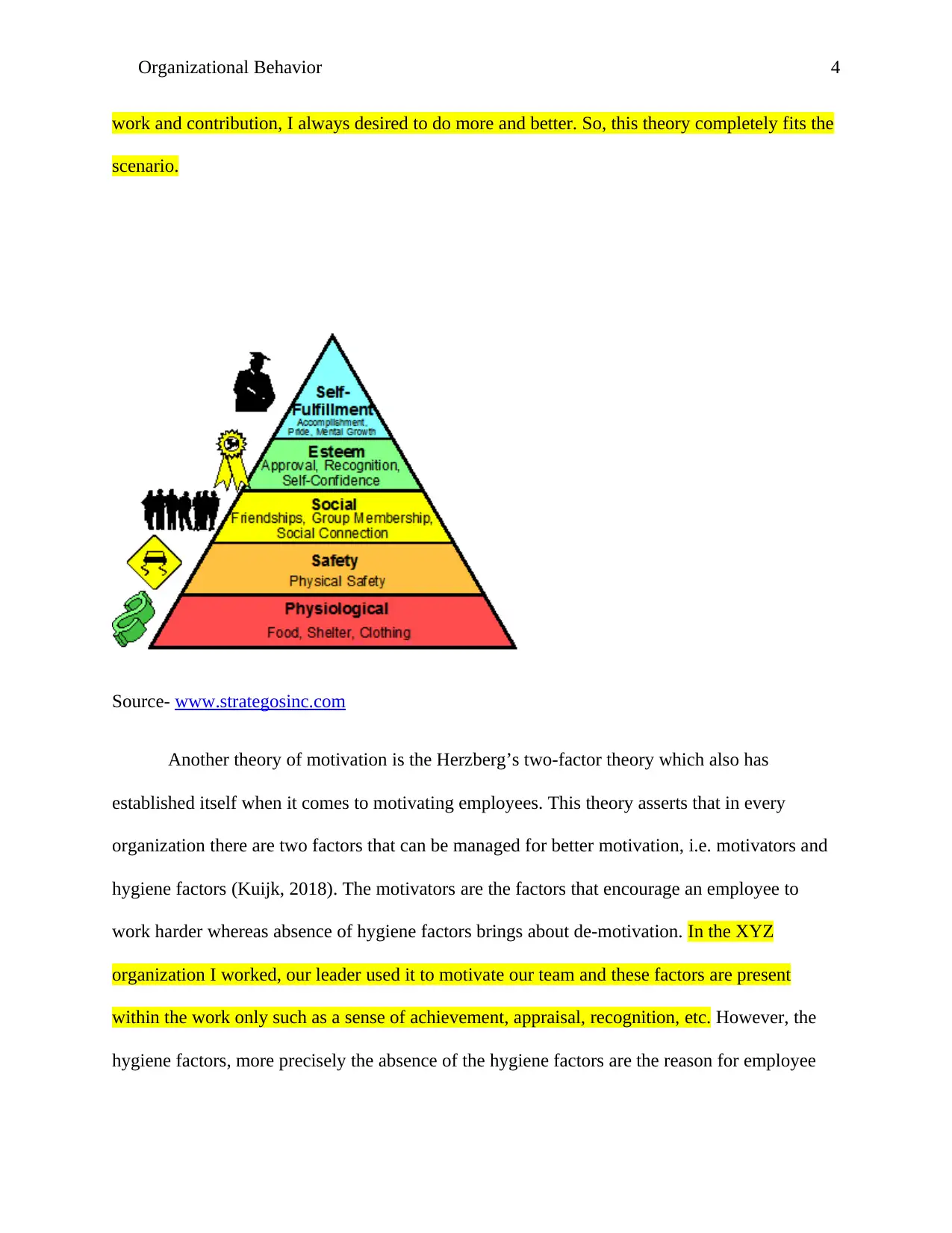
Organizational Behavior 4
work and contribution, I always desired to do more and better. So, this theory completely fits the
scenario.
Source- www.strategosinc.com
Another theory of motivation is the Herzberg’s two-factor theory which also has
established itself when it comes to motivating employees. This theory asserts that in every
organization there are two factors that can be managed for better motivation, i.e. motivators and
hygiene factors (Kuijk, 2018). The motivators are the factors that encourage an employee to
work harder whereas absence of hygiene factors brings about de-motivation. In the XYZ
organization I worked, our leader used it to motivate our team and these factors are present
within the work only such as a sense of achievement, appraisal, recognition, etc. However, the
hygiene factors, more precisely the absence of the hygiene factors are the reason for employee
work and contribution, I always desired to do more and better. So, this theory completely fits the
scenario.
Source- www.strategosinc.com
Another theory of motivation is the Herzberg’s two-factor theory which also has
established itself when it comes to motivating employees. This theory asserts that in every
organization there are two factors that can be managed for better motivation, i.e. motivators and
hygiene factors (Kuijk, 2018). The motivators are the factors that encourage an employee to
work harder whereas absence of hygiene factors brings about de-motivation. In the XYZ
organization I worked, our leader used it to motivate our team and these factors are present
within the work only such as a sense of achievement, appraisal, recognition, etc. However, the
hygiene factors, more precisely the absence of the hygiene factors are the reason for employee
Paraphrase This Document
Need a fresh take? Get an instant paraphrase of this document with our AI Paraphraser
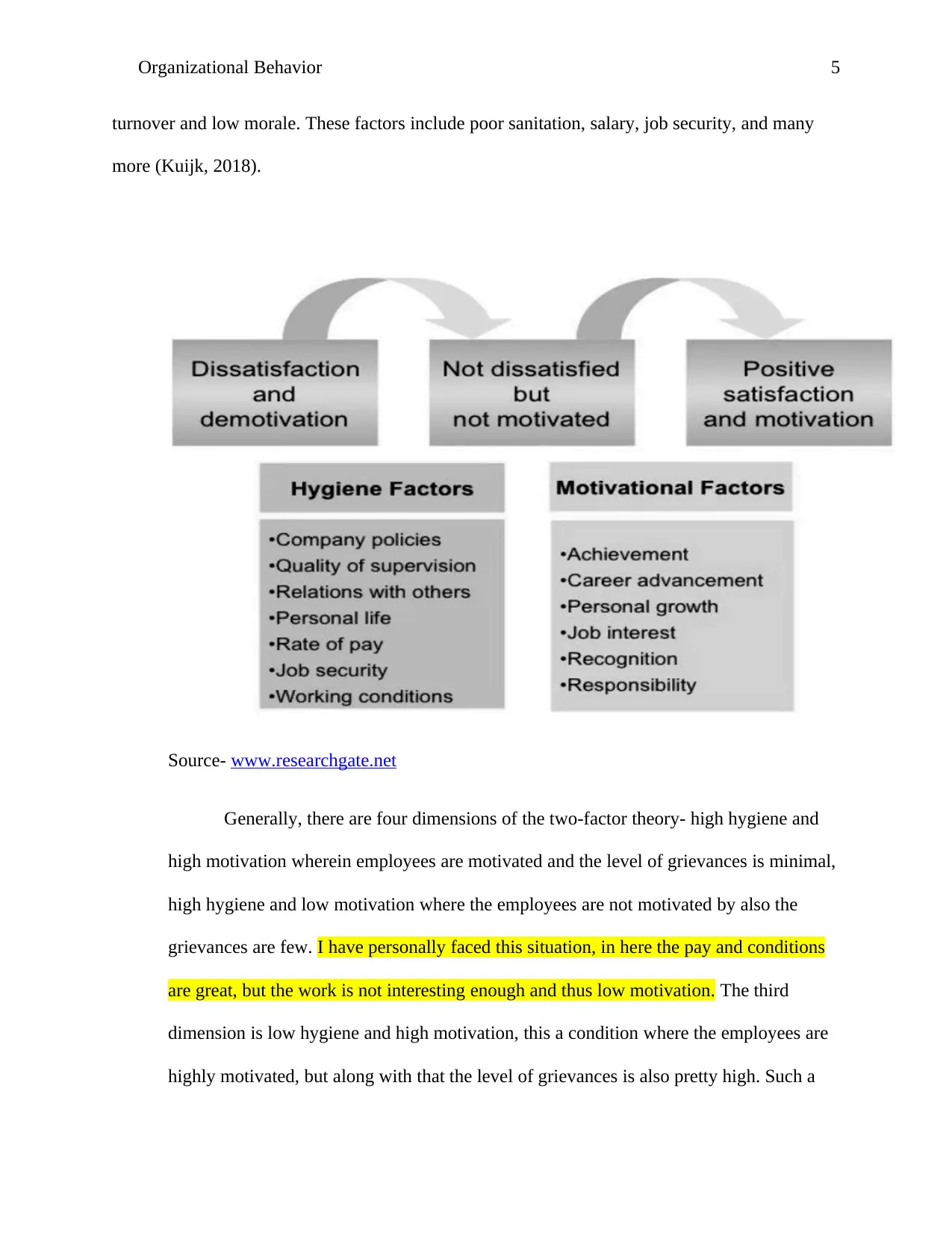
Organizational Behavior 5
turnover and low morale. These factors include poor sanitation, salary, job security, and many
more (Kuijk, 2018).
Source- www.researchgate.net
Generally, there are four dimensions of the two-factor theory- high hygiene and
high motivation wherein employees are motivated and the level of grievances is minimal,
high hygiene and low motivation where the employees are not motivated by also the
grievances are few. I have personally faced this situation, in here the pay and conditions
are great, but the work is not interesting enough and thus low motivation. The third
dimension is low hygiene and high motivation, this a condition where the employees are
highly motivated, but along with that the level of grievances is also pretty high. Such a
turnover and low morale. These factors include poor sanitation, salary, job security, and many
more (Kuijk, 2018).
Source- www.researchgate.net
Generally, there are four dimensions of the two-factor theory- high hygiene and
high motivation wherein employees are motivated and the level of grievances is minimal,
high hygiene and low motivation where the employees are not motivated by also the
grievances are few. I have personally faced this situation, in here the pay and conditions
are great, but the work is not interesting enough and thus low motivation. The third
dimension is low hygiene and high motivation, this a condition where the employees are
highly motivated, but along with that the level of grievances is also pretty high. Such a
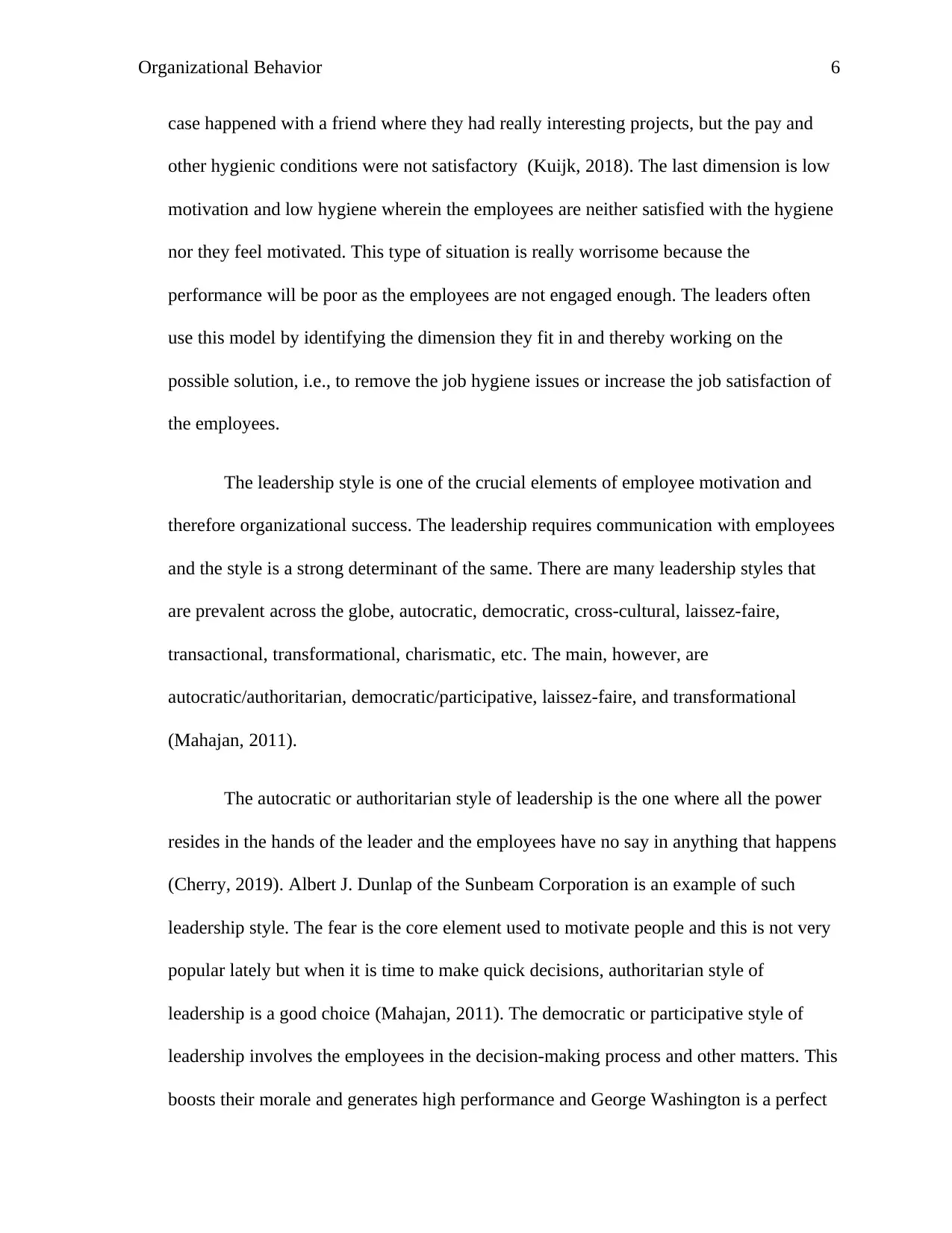
Organizational Behavior 6
case happened with a friend where they had really interesting projects, but the pay and
other hygienic conditions were not satisfactory (Kuijk, 2018). The last dimension is low
motivation and low hygiene wherein the employees are neither satisfied with the hygiene
nor they feel motivated. This type of situation is really worrisome because the
performance will be poor as the employees are not engaged enough. The leaders often
use this model by identifying the dimension they fit in and thereby working on the
possible solution, i.e., to remove the job hygiene issues or increase the job satisfaction of
the employees.
The leadership style is one of the crucial elements of employee motivation and
therefore organizational success. The leadership requires communication with employees
and the style is a strong determinant of the same. There are many leadership styles that
are prevalent across the globe, autocratic, democratic, cross-cultural, laissez-faire,
transactional, transformational, charismatic, etc. The main, however, are
autocratic/authoritarian, democratic/participative, laissez-faire, and transformational
(Mahajan, 2011).
The autocratic or authoritarian style of leadership is the one where all the power
resides in the hands of the leader and the employees have no say in anything that happens
(Cherry, 2019). Albert J. Dunlap of the Sunbeam Corporation is an example of such
leadership style. The fear is the core element used to motivate people and this is not very
popular lately but when it is time to make quick decisions, authoritarian style of
leadership is a good choice (Mahajan, 2011). The democratic or participative style of
leadership involves the employees in the decision-making process and other matters. This
boosts their morale and generates high performance and George Washington is a perfect
case happened with a friend where they had really interesting projects, but the pay and
other hygienic conditions were not satisfactory (Kuijk, 2018). The last dimension is low
motivation and low hygiene wherein the employees are neither satisfied with the hygiene
nor they feel motivated. This type of situation is really worrisome because the
performance will be poor as the employees are not engaged enough. The leaders often
use this model by identifying the dimension they fit in and thereby working on the
possible solution, i.e., to remove the job hygiene issues or increase the job satisfaction of
the employees.
The leadership style is one of the crucial elements of employee motivation and
therefore organizational success. The leadership requires communication with employees
and the style is a strong determinant of the same. There are many leadership styles that
are prevalent across the globe, autocratic, democratic, cross-cultural, laissez-faire,
transactional, transformational, charismatic, etc. The main, however, are
autocratic/authoritarian, democratic/participative, laissez-faire, and transformational
(Mahajan, 2011).
The autocratic or authoritarian style of leadership is the one where all the power
resides in the hands of the leader and the employees have no say in anything that happens
(Cherry, 2019). Albert J. Dunlap of the Sunbeam Corporation is an example of such
leadership style. The fear is the core element used to motivate people and this is not very
popular lately but when it is time to make quick decisions, authoritarian style of
leadership is a good choice (Mahajan, 2011). The democratic or participative style of
leadership involves the employees in the decision-making process and other matters. This
boosts their morale and generates high performance and George Washington is a perfect
⊘ This is a preview!⊘
Do you want full access?
Subscribe today to unlock all pages.

Trusted by 1+ million students worldwide
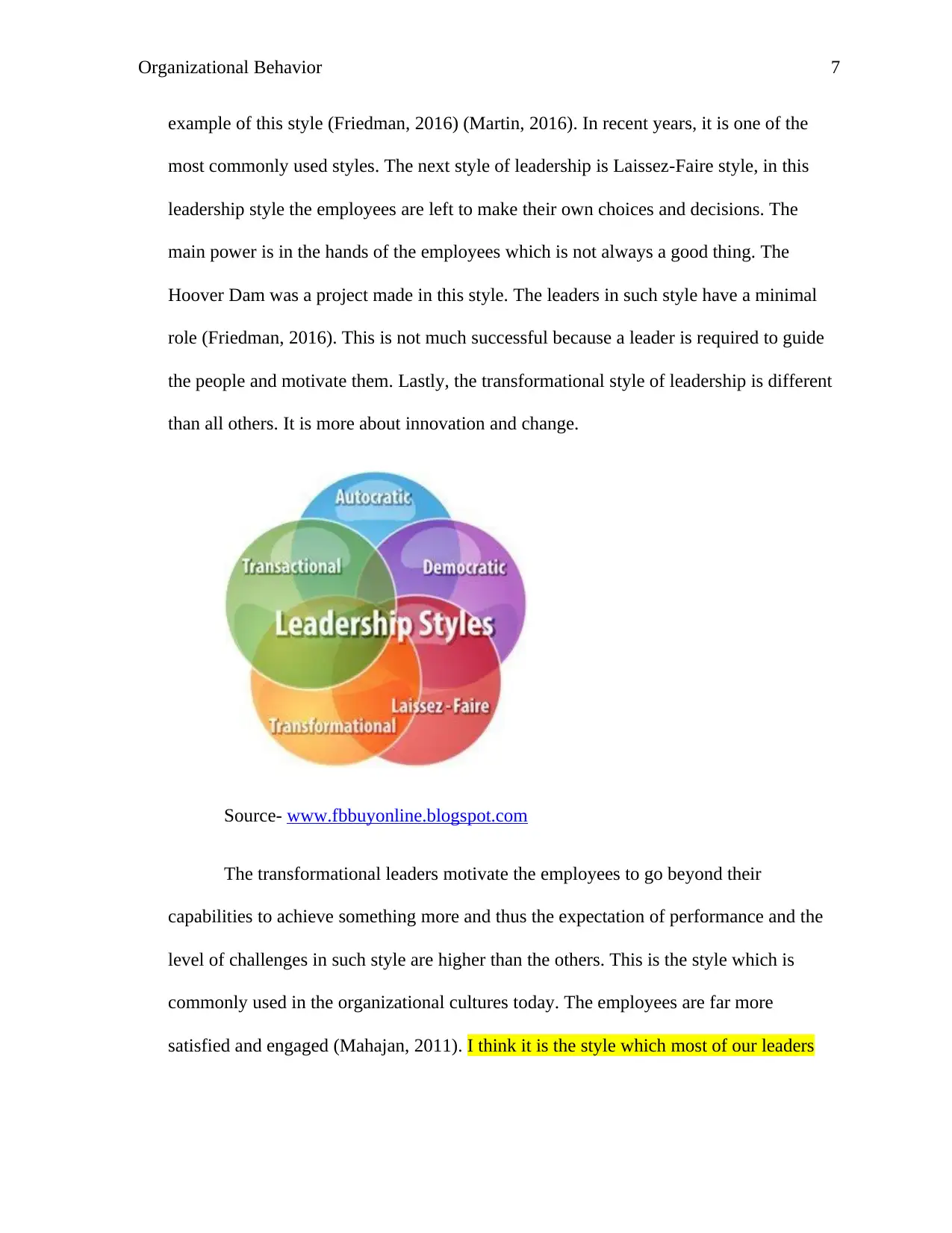
Organizational Behavior 7
example of this style (Friedman, 2016) (Martin, 2016). In recent years, it is one of the
most commonly used styles. The next style of leadership is Laissez-Faire style, in this
leadership style the employees are left to make their own choices and decisions. The
main power is in the hands of the employees which is not always a good thing. The
Hoover Dam was a project made in this style. The leaders in such style have a minimal
role (Friedman, 2016). This is not much successful because a leader is required to guide
the people and motivate them. Lastly, the transformational style of leadership is different
than all others. It is more about innovation and change.
Source- www.fbbuyonline.blogspot.com
The transformational leaders motivate the employees to go beyond their
capabilities to achieve something more and thus the expectation of performance and the
level of challenges in such style are higher than the others. This is the style which is
commonly used in the organizational cultures today. The employees are far more
satisfied and engaged (Mahajan, 2011). I think it is the style which most of our leaders
example of this style (Friedman, 2016) (Martin, 2016). In recent years, it is one of the
most commonly used styles. The next style of leadership is Laissez-Faire style, in this
leadership style the employees are left to make their own choices and decisions. The
main power is in the hands of the employees which is not always a good thing. The
Hoover Dam was a project made in this style. The leaders in such style have a minimal
role (Friedman, 2016). This is not much successful because a leader is required to guide
the people and motivate them. Lastly, the transformational style of leadership is different
than all others. It is more about innovation and change.
Source- www.fbbuyonline.blogspot.com
The transformational leaders motivate the employees to go beyond their
capabilities to achieve something more and thus the expectation of performance and the
level of challenges in such style are higher than the others. This is the style which is
commonly used in the organizational cultures today. The employees are far more
satisfied and engaged (Mahajan, 2011). I think it is the style which most of our leaders
Paraphrase This Document
Need a fresh take? Get an instant paraphrase of this document with our AI Paraphraser
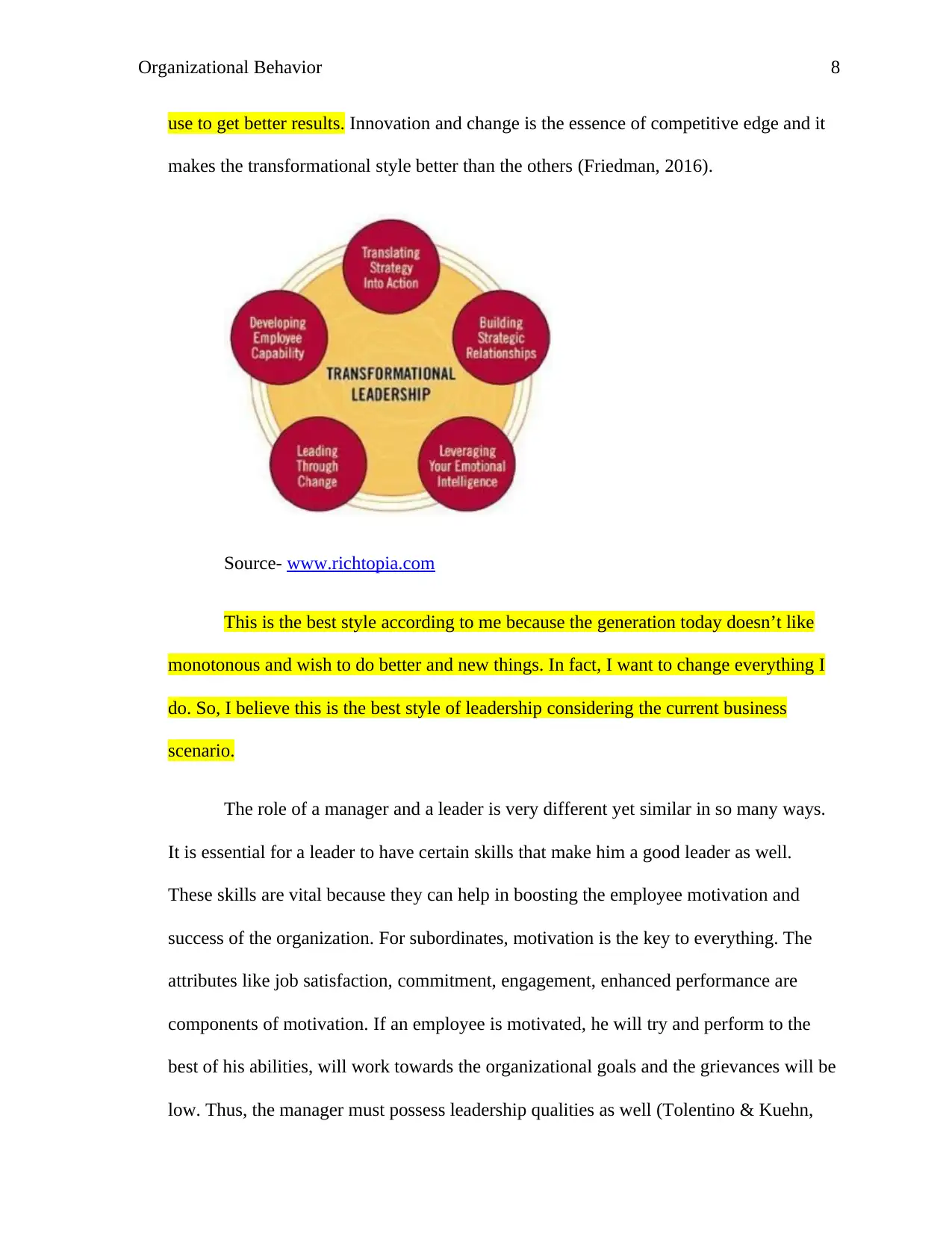
Organizational Behavior 8
use to get better results. Innovation and change is the essence of competitive edge and it
makes the transformational style better than the others (Friedman, 2016).
Source- www.richtopia.com
This is the best style according to me because the generation today doesn’t like
monotonous and wish to do better and new things. In fact, I want to change everything I
do. So, I believe this is the best style of leadership considering the current business
scenario.
The role of a manager and a leader is very different yet similar in so many ways.
It is essential for a leader to have certain skills that make him a good leader as well.
These skills are vital because they can help in boosting the employee motivation and
success of the organization. For subordinates, motivation is the key to everything. The
attributes like job satisfaction, commitment, engagement, enhanced performance are
components of motivation. If an employee is motivated, he will try and perform to the
best of his abilities, will work towards the organizational goals and the grievances will be
low. Thus, the manager must possess leadership qualities as well (Tolentino & Kuehn,
use to get better results. Innovation and change is the essence of competitive edge and it
makes the transformational style better than the others (Friedman, 2016).
Source- www.richtopia.com
This is the best style according to me because the generation today doesn’t like
monotonous and wish to do better and new things. In fact, I want to change everything I
do. So, I believe this is the best style of leadership considering the current business
scenario.
The role of a manager and a leader is very different yet similar in so many ways.
It is essential for a leader to have certain skills that make him a good leader as well.
These skills are vital because they can help in boosting the employee motivation and
success of the organization. For subordinates, motivation is the key to everything. The
attributes like job satisfaction, commitment, engagement, enhanced performance are
components of motivation. If an employee is motivated, he will try and perform to the
best of his abilities, will work towards the organizational goals and the grievances will be
low. Thus, the manager must possess leadership qualities as well (Tolentino & Kuehn,
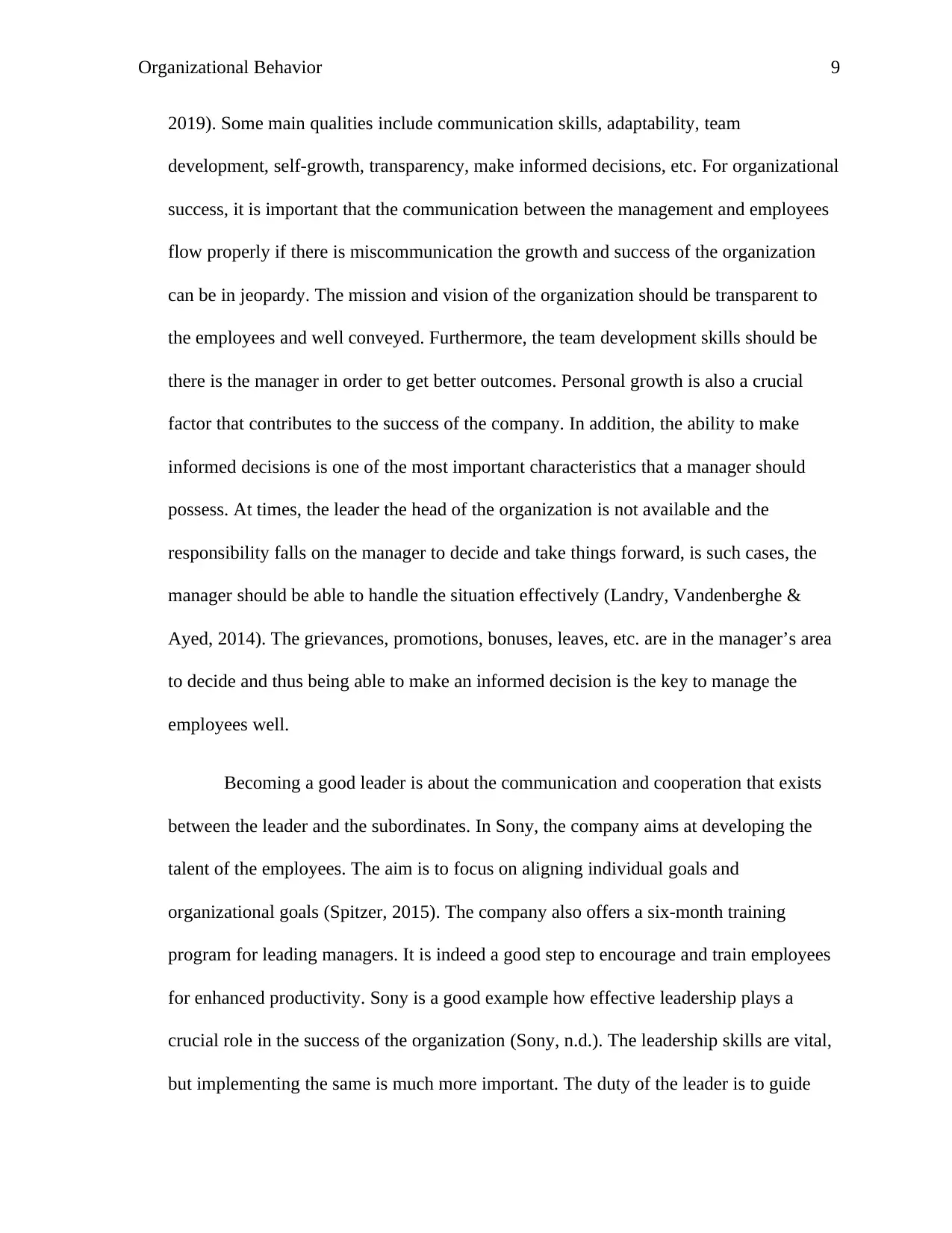
Organizational Behavior 9
2019). Some main qualities include communication skills, adaptability, team
development, self-growth, transparency, make informed decisions, etc. For organizational
success, it is important that the communication between the management and employees
flow properly if there is miscommunication the growth and success of the organization
can be in jeopardy. The mission and vision of the organization should be transparent to
the employees and well conveyed. Furthermore, the team development skills should be
there is the manager in order to get better outcomes. Personal growth is also a crucial
factor that contributes to the success of the company. In addition, the ability to make
informed decisions is one of the most important characteristics that a manager should
possess. At times, the leader the head of the organization is not available and the
responsibility falls on the manager to decide and take things forward, is such cases, the
manager should be able to handle the situation effectively (Landry, Vandenberghe &
Ayed, 2014). The grievances, promotions, bonuses, leaves, etc. are in the manager’s area
to decide and thus being able to make an informed decision is the key to manage the
employees well.
Becoming a good leader is about the communication and cooperation that exists
between the leader and the subordinates. In Sony, the company aims at developing the
talent of the employees. The aim is to focus on aligning individual goals and
organizational goals (Spitzer, 2015). The company also offers a six-month training
program for leading managers. It is indeed a good step to encourage and train employees
for enhanced productivity. Sony is a good example how effective leadership plays a
crucial role in the success of the organization (Sony, n.d.). The leadership skills are vital,
but implementing the same is much more important. The duty of the leader is to guide
2019). Some main qualities include communication skills, adaptability, team
development, self-growth, transparency, make informed decisions, etc. For organizational
success, it is important that the communication between the management and employees
flow properly if there is miscommunication the growth and success of the organization
can be in jeopardy. The mission and vision of the organization should be transparent to
the employees and well conveyed. Furthermore, the team development skills should be
there is the manager in order to get better outcomes. Personal growth is also a crucial
factor that contributes to the success of the company. In addition, the ability to make
informed decisions is one of the most important characteristics that a manager should
possess. At times, the leader the head of the organization is not available and the
responsibility falls on the manager to decide and take things forward, is such cases, the
manager should be able to handle the situation effectively (Landry, Vandenberghe &
Ayed, 2014). The grievances, promotions, bonuses, leaves, etc. are in the manager’s area
to decide and thus being able to make an informed decision is the key to manage the
employees well.
Becoming a good leader is about the communication and cooperation that exists
between the leader and the subordinates. In Sony, the company aims at developing the
talent of the employees. The aim is to focus on aligning individual goals and
organizational goals (Spitzer, 2015). The company also offers a six-month training
program for leading managers. It is indeed a good step to encourage and train employees
for enhanced productivity. Sony is a good example how effective leadership plays a
crucial role in the success of the organization (Sony, n.d.). The leadership skills are vital,
but implementing the same is much more important. The duty of the leader is to guide
⊘ This is a preview!⊘
Do you want full access?
Subscribe today to unlock all pages.

Trusted by 1+ million students worldwide
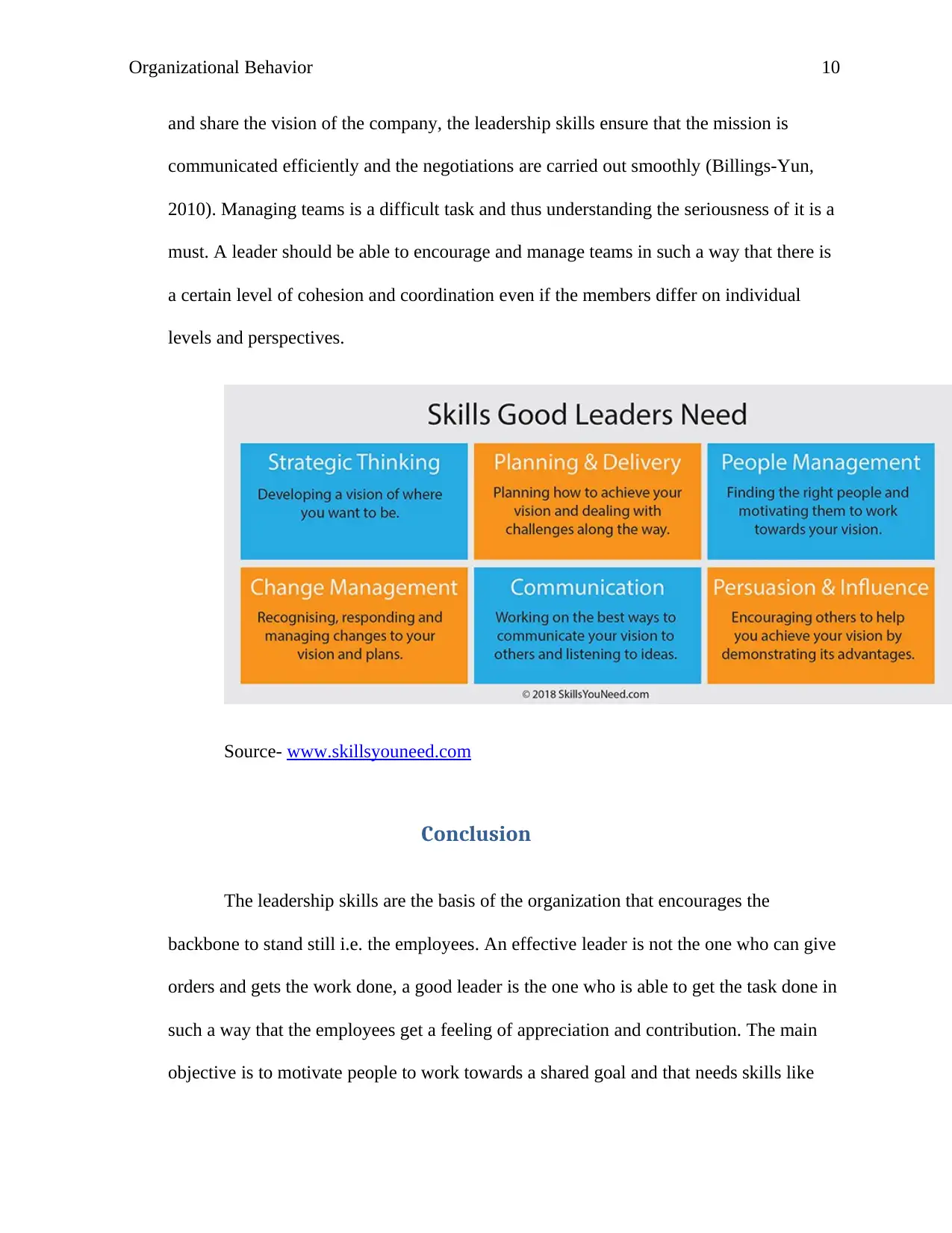
Organizational Behavior 10
and share the vision of the company, the leadership skills ensure that the mission is
communicated efficiently and the negotiations are carried out smoothly (Billings-Yun,
2010). Managing teams is a difficult task and thus understanding the seriousness of it is a
must. A leader should be able to encourage and manage teams in such a way that there is
a certain level of cohesion and coordination even if the members differ on individual
levels and perspectives.
Source- www.skillsyouneed.com
Conclusion
The leadership skills are the basis of the organization that encourages the
backbone to stand still i.e. the employees. An effective leader is not the one who can give
orders and gets the work done, a good leader is the one who is able to get the task done in
such a way that the employees get a feeling of appreciation and contribution. The main
objective is to motivate people to work towards a shared goal and that needs skills like
and share the vision of the company, the leadership skills ensure that the mission is
communicated efficiently and the negotiations are carried out smoothly (Billings-Yun,
2010). Managing teams is a difficult task and thus understanding the seriousness of it is a
must. A leader should be able to encourage and manage teams in such a way that there is
a certain level of cohesion and coordination even if the members differ on individual
levels and perspectives.
Source- www.skillsyouneed.com
Conclusion
The leadership skills are the basis of the organization that encourages the
backbone to stand still i.e. the employees. An effective leader is not the one who can give
orders and gets the work done, a good leader is the one who is able to get the task done in
such a way that the employees get a feeling of appreciation and contribution. The main
objective is to motivate people to work towards a shared goal and that needs skills like
Paraphrase This Document
Need a fresh take? Get an instant paraphrase of this document with our AI Paraphraser
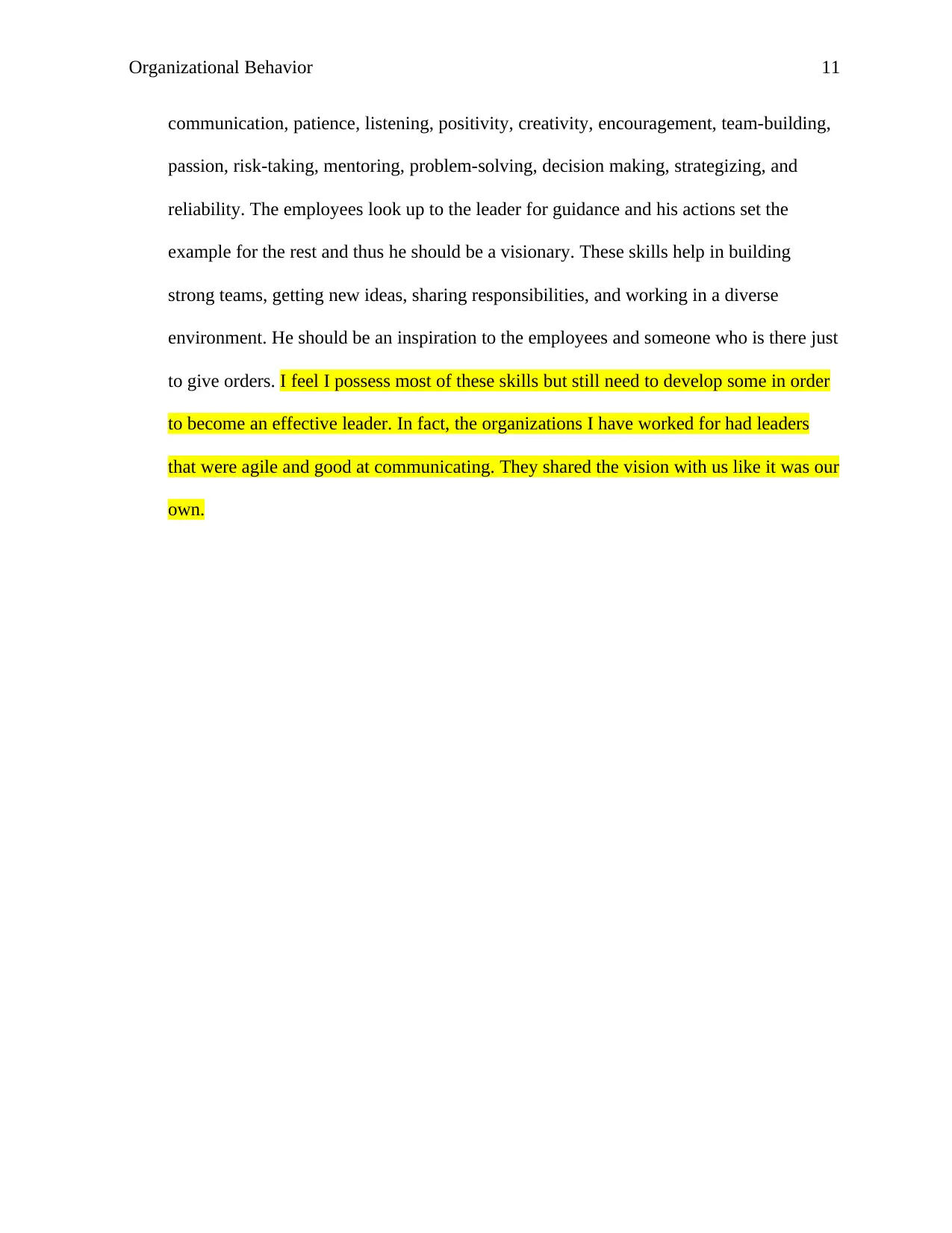
Organizational Behavior 11
communication, patience, listening, positivity, creativity, encouragement, team-building,
passion, risk-taking, mentoring, problem-solving, decision making, strategizing, and
reliability. The employees look up to the leader for guidance and his actions set the
example for the rest and thus he should be a visionary. These skills help in building
strong teams, getting new ideas, sharing responsibilities, and working in a diverse
environment. He should be an inspiration to the employees and someone who is there just
to give orders. I feel I possess most of these skills but still need to develop some in order
to become an effective leader. In fact, the organizations I have worked for had leaders
that were agile and good at communicating. They shared the vision with us like it was our
own.
communication, patience, listening, positivity, creativity, encouragement, team-building,
passion, risk-taking, mentoring, problem-solving, decision making, strategizing, and
reliability. The employees look up to the leader for guidance and his actions set the
example for the rest and thus he should be a visionary. These skills help in building
strong teams, getting new ideas, sharing responsibilities, and working in a diverse
environment. He should be an inspiration to the employees and someone who is there just
to give orders. I feel I possess most of these skills but still need to develop some in order
to become an effective leader. In fact, the organizations I have worked for had leaders
that were agile and good at communicating. They shared the vision with us like it was our
own.
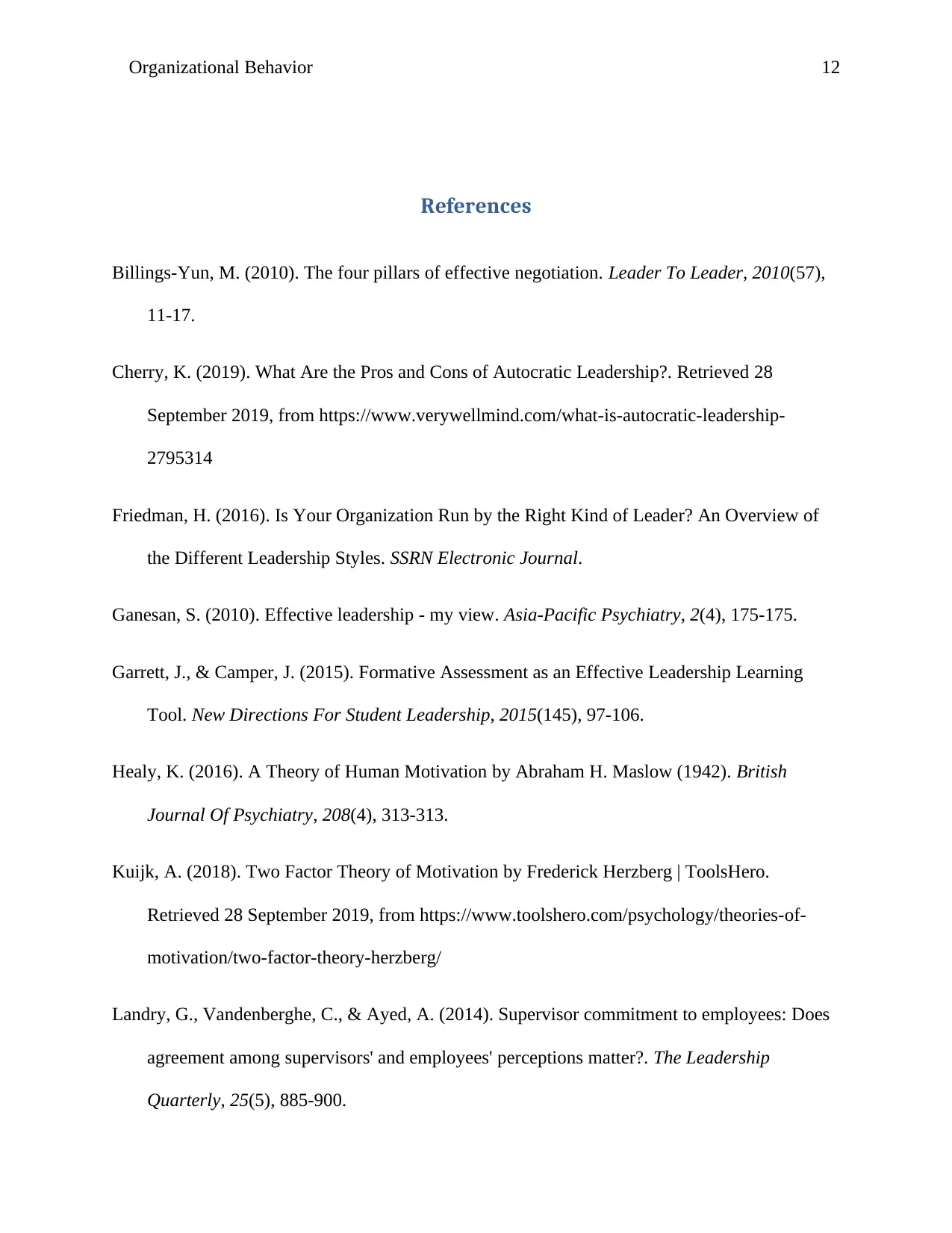
Organizational Behavior 12
References
Billings-Yun, M. (2010). The four pillars of effective negotiation. Leader To Leader, 2010(57),
11-17.
Cherry, K. (2019). What Are the Pros and Cons of Autocratic Leadership?. Retrieved 28
September 2019, from https://www.verywellmind.com/what-is-autocratic-leadership-
2795314
Friedman, H. (2016). Is Your Organization Run by the Right Kind of Leader? An Overview of
the Different Leadership Styles. SSRN Electronic Journal.
Ganesan, S. (2010). Effective leadership - my view. Asia-Pacific Psychiatry, 2(4), 175-175.
Garrett, J., & Camper, J. (2015). Formative Assessment as an Effective Leadership Learning
Tool. New Directions For Student Leadership, 2015(145), 97-106.
Healy, K. (2016). A Theory of Human Motivation by Abraham H. Maslow (1942). British
Journal Of Psychiatry, 208(4), 313-313.
Kuijk, A. (2018). Two Factor Theory of Motivation by Frederick Herzberg | ToolsHero.
Retrieved 28 September 2019, from https://www.toolshero.com/psychology/theories-of-
motivation/two-factor-theory-herzberg/
Landry, G., Vandenberghe, C., & Ayed, A. (2014). Supervisor commitment to employees: Does
agreement among supervisors' and employees' perceptions matter?. The Leadership
Quarterly, 25(5), 885-900.
References
Billings-Yun, M. (2010). The four pillars of effective negotiation. Leader To Leader, 2010(57),
11-17.
Cherry, K. (2019). What Are the Pros and Cons of Autocratic Leadership?. Retrieved 28
September 2019, from https://www.verywellmind.com/what-is-autocratic-leadership-
2795314
Friedman, H. (2016). Is Your Organization Run by the Right Kind of Leader? An Overview of
the Different Leadership Styles. SSRN Electronic Journal.
Ganesan, S. (2010). Effective leadership - my view. Asia-Pacific Psychiatry, 2(4), 175-175.
Garrett, J., & Camper, J. (2015). Formative Assessment as an Effective Leadership Learning
Tool. New Directions For Student Leadership, 2015(145), 97-106.
Healy, K. (2016). A Theory of Human Motivation by Abraham H. Maslow (1942). British
Journal Of Psychiatry, 208(4), 313-313.
Kuijk, A. (2018). Two Factor Theory of Motivation by Frederick Herzberg | ToolsHero.
Retrieved 28 September 2019, from https://www.toolshero.com/psychology/theories-of-
motivation/two-factor-theory-herzberg/
Landry, G., Vandenberghe, C., & Ayed, A. (2014). Supervisor commitment to employees: Does
agreement among supervisors' and employees' perceptions matter?. The Leadership
Quarterly, 25(5), 885-900.
⊘ This is a preview!⊘
Do you want full access?
Subscribe today to unlock all pages.

Trusted by 1+ million students worldwide
1 out of 13
Related Documents
Your All-in-One AI-Powered Toolkit for Academic Success.
+13062052269
info@desklib.com
Available 24*7 on WhatsApp / Email
![[object Object]](/_next/static/media/star-bottom.7253800d.svg)
Unlock your academic potential
Copyright © 2020–2025 A2Z Services. All Rights Reserved. Developed and managed by ZUCOL.




